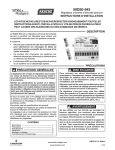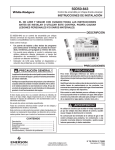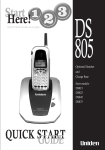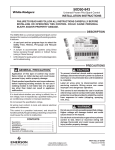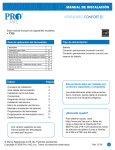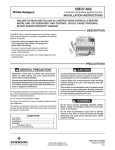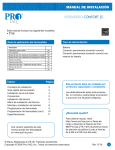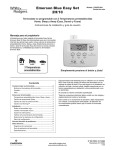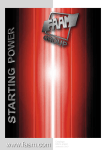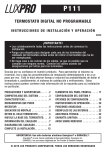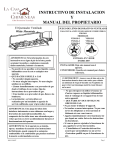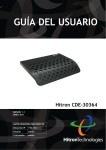Download 50D50-842 - eComfort
Transcript
50D50-842 Universal Direct Spark Control INSTALLATION INSTRUCTIONS FAILURE TO READ AND FOLLOW ALL INSTRUCTIONS CAREFULLY BEFORE INSTALLING OR OPERATING THIS CONTROL COULD CAUSE PERSONAL INJURY AND/OR PROPERTY DAMAGE. DESCRIPTION The 50D50-842 is a universal replacement Direct Spark control designed for maximum compatibility with existing systems. It features: • • • A card port and eight program keys to select the Trial for Ignition Time, Retries, Prepurge and Recycle timings. A Jumper to accommodate systems using Direct Sense (sensing through ignitor) or Indirect Sense (using a Flame Sensor) LED indicator for quick system and module diagnostics and troubleshooting. PRECAUTIONS ! GENERAL PRECAUTION ! CAUTION Application of this type of control may cause flame rollout on initial startup and could cause personal injury and/or property damage. To prevent electrical shock and/or equipment damage, disconnect electric power to system at main fuse or circuit breaker box until installation is complete. Check product specification and cross reference before replacing existing module. Do not use if existing module is not listed. Use of a program key other than listed can result in appliance malfunction. If in doubt about whether your wiring is millivolt, line, or low voltage, have it inspected by a qualified heating and air conditioning contractor or licensed electrician. Label all wires prior to disconnection when servicing controls.Wiring errors can cause improper and dangerous operation. This control is not intended for use in locations where it may come in contact with water. Suitable protection must be provided to shield the control from exposure to water (dripping, spraying, rain, etc.). Do not exceed the specification ratings. All wiring must conform to local and national electrical codes and ordinances. ! WARNING This control is a precision instrument, and should be handled carefully. Rough handling or distorting components could cause the control to malfunction. Do not use on circuits exceeding specified voltage. Higher voltage will damage control and could cause shock or fire hazard. CONTENTS Description ................................................................... Precautions .................................................................. Specifications ............................................................... Installation .................................................................... Mounting & Wiring ......................................................... Operation & Troubleshooting ........................................ 1 1 2 2 3 4 Do not short out terminals on gas valve or primary control to test. Short or incorrect wiring will damage thermostat and could cause personal injury and/or property damage. www.white-rodgers.com www.emerson.com PART NO. 37-6575E Replaces 37-6575D 0927 SPECIFICATIONS ELECTRICAL RATINGS: Program Key Timing Specifications Quick Reference Timing and Retry Input Voltage: 18 to 30 VAC, 60 Hz Current: 0.2 amp + MV @ 25OC Relay Contact Ratings: Main Valve Relay: 1.5 amp @ 25 VAC 60 Hz Spark Output: Gap: 0.1" - 0.2", 15kV 25Hz Max cable length: 3ft (0.9m) Flame Current Requirements: Minimum current to insure flame detection: 2 µA DC* Maximum current for non-detection: 0.2 µA DC Maximum allowable leakage resistance: 100 M ohms * Measured with a DC microammeter in series with the flame probe lead PROGRAM KEY (COLOR) A (blue) B (red) C (green) D (violet) E (orange) F (yellow) G (blue\red) H (red\green) TRIAL FOR IGNITION 4 Sec. 4 Sec. 7 Sec. 7 Sec. 7 Sec. 7 Sec. 11 Sec. 11 Sec. RETRIES 2 2 2 2 0 0 0 0 PREPURGE 0 Sec. 30 Sec. 0 Sec. 30 Sec. 0 Sec. 30 Sec. 0 Sec. 30 Sec. INTER PURGE 90 Sec. 90 Sec. 90 Sec. 90 Sec. N/A N/A N/A N/A Program Key OPERATING TEMPERATURE RANGE: -40° to 175°F (-40° to 80°C) HUMIDITY RANGE: To 95% relative humidity (non-condensing) MOUNTING: Surface mount or 4" x 4" junction box GASES APPROVED: Natural, Manufactured, Mixed, Liquid Petroleum, and LP Gas Air Mixtures. Fig. 1 – Program Key installation INSTALLATION MOUNTING AND WIRING ! WARNING Do not use on circuits exceeding specified voltage. Higher voltage will damage control and could cause shock or fire hazard. ! CAUTION To prevent electrical shock and/or equipment damage, disconnect electric power to system at main fuse or circuit breaker box until installation is complete. Failure to earth ground the appliance or reversing the neutral and hot wire connection to the line can cause shock hazard. Shut off main gas to heating system until installation is complete. Route and secure all wiring as far from flame as practical to prevent fire and/or equipment damage. 2 NOTE Replace control as unit – no user serviceable parts. All wiring should be installed according to local and national electrical codes and ordinances. The control may be mounted in any orientation on a convenient surface using two #6 x 5/8” sheet metal screws. If desired, control can be mounted on a 4” x 4” junction box using two #8-32 x 5/8” machine screws. The control must be secured to an area that will experience a minimum of vibration and remain below the maximum ambient temperature rating of 175°F. The control is approved for minimum ambient temperatures of –40°. Refer to the wiring diagrams and wiring table when connecting the control to other components of the system. UL approved 105°C rated 18 gauge minimum wire is recommended for all low voltage connections. UL approved 105°C rated 16 gauge minimum wire is recommended for all line voltage connections. After installation or replacement, follow appliance manufacturer’s recommended installation/service instructions to insure proper operation. SPARK PROBE Gas Valve MV FLAME Gas Valve FLAME PROBE (GND) SPARK GND FLY LEAD TH TR VAL MV SPARK FLY LEAD TH GND TR MV VAL INSTALLATION SPARK PROBE JUMPER LINK MV FLAME (GND) Burner Ground Burner Ground LIMIT CONTROLLER (GND) LIMIT CONTROLLER L1 (HOT) (GND) L1 (HOT) L2 THERMOSTAT OR CONTROLLER ALTERNATE LIMIT TRANSFORMER L2 THERMOSTAT OR CONTROLLER Fig. 2 – Typical hookup for White-Rodgers replacement with separate flame sense and spark probes ALTERNATE LIMIT TRANSFORMER Fig. 3 – Typical hookup for White-Rodgers replacement with direct flame sense through single spark/sense probe NOTE: Max length of spark cable should be less than 3ft (0.9m) and rated at 15kV. The cable must not run in continuous contact with any metal surface or spark voltage is greatly reduced. Use ceramic or plastic standoff insulators as required. Ensure burner is grounded directly to module for spark return path. INSTALL PROGRAM KEY The control replaces all listed models with the following features: • direct spark ignition • remote rod flame sense or direct flame sense through ignitor • one or three ignition tries • four to eleven second trial for ignition time • pre-purge options zero or 30 seconds Eight program keys are provided for different applications. Timings and Retries for each program key are shown in the Specifications section on page 2 of this installation manual. Choose the proper program key for the application. Install the selected program key in the slot on the left side of the module (see figure 1) and fit the timing label on the cover. If the module you are replacing is not listed in the table contact the manufacturer of the appliance for a recommended replacement or retrofit. After inserting the proper program key, dispose of the remaining keys to ensure the correct key remains in the module. If control fails to operate see troubleshooting guide for remedy. TABLE 2. Cross Reference for Program Key and Wiring Instruction MANUFACTURER MODEL KEY WIRING Honeywell S8680 (generic) Various Fig 2 / 3 Honeywell S87B1008 C (green) Fig 3 Honeywell S87B1016 G (blue\red) Fig 3 Honeywell S87C1006 C (green) Fig 2 Honeywell S87C1014 G (blue\red) Fig 2 Honeywell S87D1004 C (green) Fig 2 Honeywell S87D1012 G (blue\red) Fig 2 Honeywell S87J1026 H (red\green) Fig 3 Robertshaw DS845 780-504 C (green) Fig 2 / 3 White-Rodgers 50D20-50 A (blue) Fig 2 / 3 White-Rodgers 50D20-51 A (blue) Fig 2 / 3 White-Rodgers 50D20-52 A (blue) Fig 2 / 3 White-Rodgers 50D20-150 C (green) Fig 2 / 3 White-Rodgers 50D20-152 C (green) Fig 2 / 3 White-Rodgers 50D20-160 D(violet) Fig 2 / 3 White-Rodgers 50D20-162 D(violet) Fig 2 / 3 White-Rodgers 50D21-1 A (blue) Fig 2 / 3 White-Rodgers 50D21-60 D(violet) Fig 2 / 3 3 OPERATION TYPICAL FURNACE INSTALLATION In a typical application the 50D50-842 is designed to generate sparks and energize the gas valve and monitor the flame sensor. It is a 100% shut off design that locks out the gas valve if the burner does not light within the trial for ignition period. The ignition sequence begins with a call for heat from the room thermostat. The thermostat applies power to the control. After prepurge interval, the valve is energized and sparks are generated for the selected trial for ignition time. If the burner lights within the allowed period the gas valve will remain open until the call for heat is satisfied. If the burner does not light, the control will either go into lockout or make two more ignition retries depending on the options selected. The control can be reset from lockout by cycling the thermostat to remove power for a minimum of 10 seconds. It includes a system analysis/troubleshooting LED that indicates normal operation, lockout, or control fault. TROUBLESHOOTING For proper control operation, the control must be electrically connected to the gas valve and all the ignition wiring connectors plugged in. Gas valves with an electric "ON/OFF" switch must have the switch set to "ON". The light on the control provides a self-diagnosis indication. If the red light on the module is off continuously, the fault is likely to be internal to the module. To make sure, interrupt the line or 24 volt thermostat power for 10 seconds, check program key installation and then restore. If the internal fault is indicated again, and flame sensor is not shorted to ground, replace the control. A flashing light indicates a problem, most likely in the external components or wiring (see chart below). Proceed as follows: Visual checks 1) After the prepurge delay (if applicable) the valve opens and the ignition (sparks) starts 2) The burner flame will light 3) The ignition (sparks) stops Troubleshooting the system consists of checking for these visual indications. The chart on the next page defines the proper action if any of these indications does not occur. 4 LED Condition Solid On One Flash Two Flashes Three Flashes Four Flashes Five Flashes OFF Normal - Control ON False flame signal No Flame Detected Safety Drive Fault N/A MV Drive Fault No Power / Internal Fault TROUBLESHOOTING Call for heat, Thermostat contacts close Does the LED stay OFF? YES Check low voltage to module (TH-TR). If no voltage: Check Limit Switches If correct voltage present: Unit has internal fault - replace. NO Does it give 1 Flash? YES Check flame probe and wiring - Unit is seeing a flame signal with valve closed Check for poor burner ground wiring Check for partial shorting on flame probe wiring NO Does it give 3 Flashes? YES There is a fault in the internal safety relay drive - Check supply voltage is within spec. If it is - replace control NO Does it give 5 Flashes? YES There is an internal fault with the Main Valve relay Check for short between TH and MV If no external cause - replace control NO After Pre-purge Does Valve operate and sparks start? NO Check wiring to Valve if it does not operate - replace Valve if voltage present Check spark wiring for shorts if no sparks Check sparks are at burner, not to outer casing Ensure no breaks or cracks in insulation of spark lead Ensure pilot flame reaches flame sensor for detection YES Does it give 2 Flashes? YES Burner has failed to light after permitted attempts Check gas supply and pressure to valve Check sparks and wiring as above NO Does system run until call for heat ends? NO Check limit switches, Check sensor leads, Check ground continuity Check flame remains on flame sensor Check gas jets are clear, Check for clean burn YES Normal Operation 5 White-Rodgers is a division of Emerson Electric Co. The Emerson logo is a trademark and service mark of Emerson Electric Co. www.white-rodgers.com www.emerson.com White-Rodgers es una división de Emerson Electric Co. El logotipo de Emerson es una marca comercial y una marca de servicio de Emerson Electric Co. www.white-rodgers.com www.emerson.com SOLUCIÓN DE PROBLEMAS Llamada de calor, los contactos del termostato se cierran ¿El LED permanece APAGADO? SÍ Verifique si el voltaje al módulo es bajo (TH-TR). Si no hay voltaje: Verifique los interruptores limitadores Si el voltaje es correcto: La unidad tiene una falla. Cámbiela. NO ¿Tiene 1 intermitente? SÍ NO ¿Tiene 3 intermitentes? SÍ Verifique la sonda de llama y las conexiones - La unidad detecta una señal de llama cuando la válvula está cerrada Verifique que estén bien las conexiones a tierra del quemador Verifique que no haya un cortocircuito parcial en las conexiones de la sonda de la llama Hay una falla en el mecanismo de relé de seguridad interno - Verifique que el voltaje de alimentación cumpla con las especificaciones Si cumple, cambie el control. NO ¿Tiene 5 intermitentes? SÍ NO Después del pre-purgado, ¿la válvula funciona y comienzan a generarse las chispas? NO SÍ ¿Tiene 2 intermitentes? SÍ Hay una falla interna en el relé de la válvula principal Verifique que no haya un cortocircuito entre TH y MV Si no hay ninguna causa externa, cambie el control. Verifique las conexiones a la válvula, si no funciona - cambie la válvula si recibe voltaje Verifique que las conexiones de encendido no estén en cortocircuito si no hay chispas Verifique que las chispas se produzcan en el quemador, no en la caja externa Asegúrese de que no haya roturas ni grietas en el aislamiento del cable de encendido Asegúrese de que la llama piloto llegue al detector de llamas para su detección El quemador no se ha encendido después de los intentos permitidos Verifique el suministro de gas y la presión a la válvula Verifique las chispas y las conexiones según se indica más arriba NO ¿El sistema funciona hasta que termina la llamada de calor? NO Verifique los interruptores limitadores, Verifique los cables del detector, Verifique la continuidad de la conexión a tierra Verifique que la llama permanezca en el detector de llama Verifique que los chorros de gas estén limpios, Verifique que la combustión sea limpia SÍ Funcionamiento normal 5 FUNCIONAMIENTO INSTALACIÓN TÍPICA DE LA CALDERA En una aplicación típica el 50D50-842 está diseñado para generar chispas y energizar la válvula de gas y monitorear el detector de llama. Es un diseño con cierre 100% que bloquea la válvula de gas si el quemador no se enciende dentro del período de prueba de encendido. La secuencia de encendido comienza con una llamada de calor del termostato de la habitación. El termostato aplica alimentación al control. Después del intervalo de pre-purgado, la válvula se energiza y se generan chispas durante el período de prueba de encendido seleccionado. Si el quemador se enciende dentro del período permitido, la válvula de gas permanecerá abierta hasta que se satisfaga la llamada de calor. Si el quemador no se enciende, el control se bloqueará o realizará dos intentos más de encendido según las opciones seleccionadas. El control puede desbloquearse encendiendo y apagando el termostato para desconectar la alimentación durante un mínimo de 10 segundos. Incluye un LED de análisis del sistema/solución de problemas que indica funcionamiento normal, bloqueo o falla del control. SOLUCIÓN DE PROBLEMAS Para el funcionamiento adecuado del control, éste debe estar eléctricamente conectado a la válvula de gas y todos los conectores de los cables de encendido deben estar enchufados. Las válvulas de gas con un interruptor eléctrico de APAGADO/ENCENDIDO deben tener el interruptor colocado en la posición ENCENDIDO. La luz del control proporciona una indicación de autodiagnóstico. Si la luz roja del módulo está permanentemente apagada, es probable que se trate de una falla interna del módulo. Para asegurarse, interrumpa la alimentación de línea o la alimentación de 24 voltios al termostato durante 10 segundos, compruebe la tecla del programa y luego vuelva a conectarla. Si vuelve a indicar una falla interna y el detector de llama no está en cortocircuito con tierra, cambie el control. Una luz intermitente indica que es muy probable que el problema se encuentre en los componentes externos o en las conexiones (vea el siguiente cuadro). Proceda como se indica a continuación: Verificaciones visuales Se detiene el encendido (chispas) 3) La llama del quemador se enciende 2) Después del retardo de pre-purgado (si corresponde), la válvula se abre y comienza el encendido (chispas) 1) La solución de problemas del sistema consiste en verificar estas indicaciones visuales. El cuadro de la siguiente página indica cómo proceder si no se produce ninguna de estas indicaciones. LED Encendido fijo Un intermitente Dos intermitentes Tres intermitentes Cuatro intermitentes Cinco intermitentes APAGADO Estado Normal - Control ENCENDIDO Señal de llama falsa No se detectó llama Falla de mecanismo de seguridad N/A Falla del mecanismo MV No hay alimentación / Falla interna 4 INSTALACIÓN MV VAL TR TH GND CABLE FLY ENCENDIDO MV VAL TR TH GND SONDA DE ENCENDIDO Válvula de gas MV LLAMA SONDA DE LLAMA (GND) Válvula de gas CABLE FLY ENCENDIDO SONDA DE ENCENDIDO PUENTE MV LLAMA (GND) Tierra del quemador Tierra del quemador CONTROLADOR DE LÍMITE (GND) CONTROLADOR DE LÍMITE L1 (VIVO) (GND) L1 (VIVO) L2 TERMOSTATO O CONTROLADOR LÍMITE ALTERNO L2 TRANSFORMADOR TERMOSTATO O CONTROLADOR Fig. 2 – Conexión típica para el repuesto de White-Rodgers con detección de llama separada y sondas de encendido LÍMITE ALTERNO TRANSFORMADOR Fig. 3 – Conexión típica para el repuesto de White-Rodgers con detección de llama directa a través de una sola sonda de encendido/detección NOTA: la longitud del cable de encendido debe ser de 3 pies (0.9 m) como máximo, con un voltaje nominal de 15 kV. El cable no debe estar en contacto permanente con ninguna superficie metálica ya que esto podría reducir considerablemente el voltaje de encendido. Utilice aisladores distanciadores de cerámica o plástico según sea necesario. Asegúrese de que el quemador esté conectado a tierra directamente al módulo para el circuito de retorno de encendido. INSTALE LA TECLA DE PROGRAMA El control reemplaza todos los modelos incluidos en la lista con las siguientes características: • encendido de chispa directo • detección de llama con varilla remota o detección de llama directa a través del dispositivo de encendido • uno o tres intentos de encendido • tiempos de segundo intento de encendido de cuatro a once segundos • opciones de pre-purgado cero o 30 segundos Se suministran ocho teclas de programa para diferentes aplicaciones. Los tiempos y el número de reintentos para cada tecla de programa se indican en la sección Especificaciones, en la página 2 de este manual de instalación. Elija la tecla de programa adecuada para la aplicación. Instale la tecla de programa seleccionada en la ranura del lado izquierdo del módulo (vea la figura 1) y coloque la etiqueta de tiempo sobre la cubierta. Si el módulo que desea cambiar no está incluido en la tabla, póngase en contacto con el fabricante del equipo para consultar por un repuesto o reacondicionamiento recomendado. Después de insertar la tecla de programa adecuada, deseche las teclas restantes para asegurarse de que quede la tecla correcta en el módulo. Si el control no funciona correctamente, vea cómo proceder en la guía de solución de problemas. TABLA 2. Referencia cruzada de teclas de programa e instrucciones de conexión FABRICANTE MODELO Honeywell TECLA S8680 (genérica) Honeywell CONEXIÓN Varios S87B1008 Honeywell Fig. 2 / 3 C (verde) S87B1016 Honeywell Fig 3 G (azul\rojo) S87C1006 Honeywell Fig 3 C (verde) S87C1014 Honeywell Fig 2 G (azul\rojo) S87D1004 Honeywell Fig 2 C (verde) S87D1012 Honeywell Fig 2 G (azul\rojo) S87J1026 Robertshaw Fig 2 H (rojo\verde) DS845 780-504 White-Rodgers Fig 3 C (verde) 50D20-50 White-Rodgers Fig 2 / 3 A (azul) 50D20-51 White-Rodgers Fig 2 / 3 A (azul) 50D20-52 White-Rodgers Fig 2 / 3 A (azul) 50D20-150 White-Rodgers Fig 2 / 3 C (verde) 50D20-152 White-Rodgers Fig 2 / 3 C (verde) 50D20-160 White-Rodgers Fig 2 / 3 D(violeta) 50D20-162 White-Rodgers Fig 2 / 3 D(violeta) 50D21-1 White-Rodgers Fig 2 / 3 A (azul) 50D21-60 Fig 2 / 3 D(violeta) Fig 2 / 3 3 ESPECIFICACIONES CARACTERÍSTICAS ELÉCTRICAS: Voltaje de entrada: 18 a 30 VCA, 60 Hz Corriente: 0.2 amp + MV a 25º C Características de contacto de los relés: Relé de válvula principal: 1.5 amp a 25 VCA 60 Hz Salida de encendido: Espacio: 0.1 pulg. - 0.2 pulg., 15 kV 25 Hz Longitud de cable máxima: 3 pies (0.9 m) Requisitos de corriente de llama: Corriente mínima para asegurar la detección de la llama: 2 µA CC* Corriente máxima para la no detección: 0.2 µA CC Resistencia a fugas máxima permitida: 100 M ohmios * Medida con un microamperímetro de CC en serie con el electrodo de sonda de llama Especificaciones de tiempos de las teclas de programa Referencia rápida Tiempos y reintento TECLA DE PRUEBA PROGRAMA DE REPREENTRE (COLOR) ENCENDIDO INTENTOS PURGADOPURGADOS A (azul) 4 Seg. 2 0 Seg. 90 Seg. B (roja) 4 Seg. 2 30 Seg. 90 Seg. C (verde) 7 Seg. 2 0 Seg. 90 Seg. D (violeta) 7 Seg. 2 30 Seg. 90 Seg. E (anaranjada) 7 Seg. 0 0 Seg. N/A F (amarilla) 7 Seg. 0 30 Seg. N/A G (azul\rojo) 11 Seg. 0 0 Seg. N/A H (rojo\verde) 11 Seg. 0 30 Seg. N/A Tecla de programa RANGO DE TEMPERATURA OPERATIVA: -40° a 175°F (-40° a 80°C) RANGO DE HUMEDAD: Hasta 95% de humedad relativa (sin condensación) SOPORTE: Soporte de superficie o caja de conexiones de 4 pulg. x 4 pulg GASES APROBADOS: natural, fabricado, mixto, gas licuado de petróleo (GLP) y mezclas de aire y GLP. Fig. 1 – Instalación de la tecla de programa INSTALACIÓN Todas las conexiones eléctricas deben realizarse conforme a los códigos y reglamentaciones locales y nacionales. Para evitar descargas eléctricas y/o daños al equipo, desconecte la alimentación eléctrica en la caja de fusibles o disyuntores principal hasta que haya finalizado la instalación del sistema. Si no se conecta a tierra el equipo o se invierte la conexión del cable neutro y el vivo a la línea pueden producirse riesgos de descarga eléctrica. Cambie el control entero en caso de ser necesario. No contiene piezas que puedan ser reparadas por el usuario. ! ¡PRECAUCIÓN! NOTA MONTAJE Y CONEXIONES Cierre la alimentación de gas principal al sistema de calefacción hasta haber terminado la instalación. Pase y fije todos los cables lo más lejos posible de la llama para evitar incendios y/o daños al equipo. ! ¡ADVERTENCIA! No utilizar en circuitos que excedan el voltaje especificado ya que los voltajes más altos dañarán el control y pueden causar riesgos de electrocución o incendio. El control puede montarse con cualquier orientación sobre una superficie conveniente usando dos tornillos autorroscantes calibre 6 x 5/8 pulg. Si lo desea, el control puede montarse sobre una caja de conexiones de 4 pulg. x 4 pulg. usando dos tornillos mecánicos calibre 8-32 x 5/8 pulg. El control debe fijarse en un lugar que esté sujeto a un mínimo de vibraciones y que se mantenga por debajo de la temperatura ambiente nominal de 175°F. El control está aprobado para temperaturas ambientes mínimas de –40°. Refiérase a los diagramas y a la tabla de conexiones para conectar el control a otros componentes del sistema. Para todas las conexiones de bajo voltaje se recomienda utilizar cables calibre 18 como mínimo aptos para 105°C y aprobados por las normas UL. Para todas las conexiones de voltaje de línea se recomienda utilizar cables calibre 16 como mínimo aptos para 105°C y aprobados por las normas UL. Una vez finalizada la instalación o el reemplazo, siga las instrucciones de instalación/mantenimiento recomendadas por el fabricante del equipo para asegurar su correcto funcionamiento. 2 50D50-842 Control de encendido por chispa directa universal INSTRUCCIONES DE INSTALACIÓN EL NO LEER Y SEGUIR CON CUIDADO TODAS LAS INSTRUCCIONES ANTES DE INSTALAR O UTILIZAR ESTE CONTROL PODRÍA CAUSAR LESIONES PERSONALES Y/O DAÑOS MATERIALES. DESCRIPCIÓN El 50D50-842 es un control de encendido por chispa directa universal de repuesto diseñado para ofrecer la máxima compatibilidad con los sistemas existentes. Este control incluye: • • • Un puerto de tarjeta y ocho teclas de programa para seleccionar el tiempo de prueba de encendido, reintentos, pre-purgado y reinicio de ciclo. Un puente para adaptar el control a sistemas que utilizan detección directa (detección a través del dispositivo de encendido) o detección indirecta (usando un detector de llama). Indicador de LED para facilitar el diagnóstico y solución de problemas en el sistema y el módulo. PRECAUCIONES Para evitar descargas eléctricas y/o daños al equipo, desconecte la alimentación eléctrica en la caja de fusibles o disyuntores principal hasta que haya finalizado la instalación del sistema. La aplicación de este tipo de control podría causar llamaradas al poner en marcha el equipo y producir lesiones personales y/o daños materiales. ! ¡PRECAUCIÓN! ! ¡PRECAUCIÓN GENERAL! Verifique las especificaciones del producto y las referencias cruzadas antes de cambiar el módulo existente. No lo utilice si el módulo existente no está incluido en la lista. El uso de una tecla de programa que no esté incluida en la lista puede producir el mal funcionamiento del equipo. Si tiene dudas acerca de si su conexión eléctrica es milivoltio, de línea o de bajo voltaje, hágala inspeccionar por un técnico especializado en equipos de calefacción y aire acondicionado o por un electricista autorizado. Identifique todos los cables antes de desconectarlos cuando realice tareas de mantenimiento en los controles. Los errores en las conexiones pueden dar lugar al funcionamiento incorrecto y peligroso del dispositivo. Este control no está diseñado para ser utilizado en lugares en los que puede entrar en contacto con agua. Debe proporcionarse una protección adecuada para proteger el control de su exposición al agua (goteo, rociado, lluvia, etc.). No exceda los valores nominales especificados. Todas las conexiones eléctricas deben cumplir con los códigos y reglamentaciones locales y nacionales. Este control es un instrumento de precisión y debe manipularse con cuidado. La manipulación descuidada o la distorsión de los componentes podrían hacer que el control no funcionara correctamente. CONTENIDO Descripción .................................................................. Precauciones ............................................................... Especificaciones .......................................................... Instalación .................................................................... Montaje y Conexiones .................................................. Funcionamiento y Solución de problemas ................... 1 1 2 2 2 4 ! ¡ADVERTENCIA! No utilizar en circuitos que excedan el voltaje especificado ya que los voltajes más altos dañarán el control y pueden causar riesgos de electrocución o incendio. No cortocircuite las terminales de la válvula de gas ni del control principal para probarlos. Un cortocircuito o una conexión incorrecta dañará el termostato y podría causar lesiones personales y/o daños materiales. www.white-rodgers.com www.emerson.com N° DE PIEZA 37-6575E Reemplaza 37-6575D 0927












